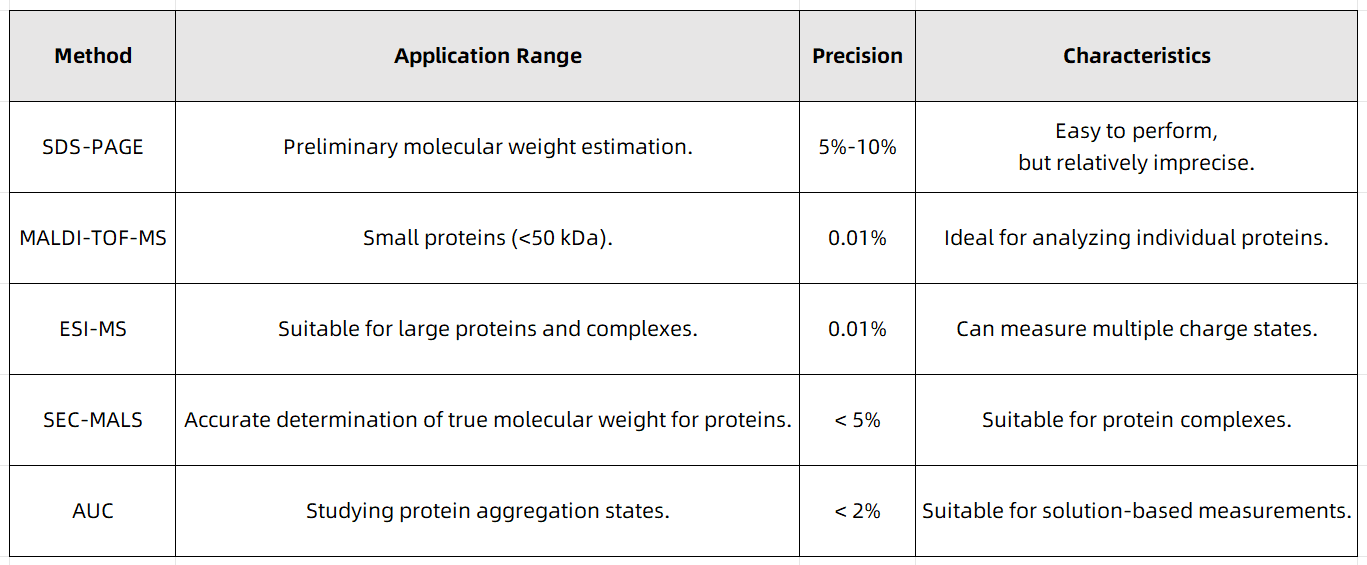How to Determine Protein Molecular Weight for Precise Research Findings
Precise molecular weight data not only aid researchers in understanding protein structure and function, but also play a critical role in areas such as biopharmaceuticals, protein interaction studies, and disease biomarker discovery. However, obtaining high-precision and reproducible protein molecular weight data remains challenging due to the inherent complexity of proteins and the limitations of various measurement techniques. This paper will explore strategies for determining protein molecular weight for precise research findings, focusing on optimizing experimental methods, selecting appropriate techniques, and minimizing errors.
Factors Affecting the Accuracy of Protein Molecular Weight Determination
Several factors can contribute to deviations in protein molecular weight data, including the intrinsic properties of proteins, limitations in measurement methods, and variations in experimental conditions.
1. Intrinsic Properties of Proteins
(1) Post-translational Modifications (PTMs) and Molecular Weight Changes
Proteins often undergo post-translational modifications (PTMs), such as:
①Glycosylation (N-glycosylation, O-glycosylation): These modifications increase molecular weight and may result in multiple peaks due to glycan heterogeneity.
②Phosphorylation: Increases molecular weight and alters the protein’s charge state.
③Acetylation, Methylation, etc.: Typically cause minor mass changes, but they must still be considered in high-resolution measurements.
(2) Protein Aggregation and Dissociation
①Certain proteins form dimers, oligomers, or higher-order aggregates, which can lead to an overestimation of molecular weight.
②Under some experimental conditions, protein complexes may dissociate, causing instability in molecular weight measurements.
(3) Effects of Conformational Changes on Determination
①Proteins in different denatured or folded states behave differently during size-exclusion chromatography (SEC) or analytical ultracentrifugation (AUC).
②For instance, a compact spherical protein and an unfolded linear protein may have the same molecular weight but exhibit different elution profiles, which affects measurement outcomes.
2. Methodological Limitations
Each protein molecular weight determination method has inherent strengths and limitations, and some can introduce systematic errors.
(1) Sodium Dodecyl Sulfate Polyacrylamide Gel Electrophoresis (SDS-PAGE)
①This technique provides only a relative estimate of molecular weight, with errors ranging from 5%-10%.
②Variability in the binding efficiency of SDS to proteins can affect their migration and the precision of the results.
(2) Mass Spectrometry (MALDI-TOF-MS, ESI-MS)
①Mass spectrometry provides high-precision molecular weight data (error < 0.01%), but removal of interfering substances (e.g., salts, buffers) is essential for accurate ionization.
②For large proteins, MALDI-TOF may produce multiple charge distributions, complicating data analysis.
(3) Size-Exclusion Chromatography (SEC)
①Relies on calibration curves with standard proteins, but the varying solvent interactions between different proteins can lead to errors in elution volumes.
②It cannot distinguish between proteins with identical molecular weights but different conformations.
(4) Analytical Ultracentrifugation (AUC):
①AUC directly measures true molecular weight but is highly sensitive to temperature, pH, and buffer composition.
②Although suitable for large proteins and protein complexes, the method is technically complex.
3. Experimental and Operational Errors
Even with high-precision methods, operational errors and environmental factors can affect the final data.
(1) Sample Preparation: Contaminants such as salts, detergents, or buffers in protein samples can interfere with methods like electrophoresis or mass spectrometry.
(2) Instrument Calibration: Improper or infrequent calibration of instruments may lead to inaccurate measurements.
(3) Experimental Conditions: Variations in temperature, pH, and ionic strength can destabilize proteins, affecting molecular weight measurements.
How to Determine Protein Molecular Weight for Precise Research Findings?
To ensure the accuracy of protein molecular weight determination, researchers must adopt optimized experimental strategies, utilize advanced methodologies, and implement stringent quality control. The following are key approaches to improving the accuracy of protein molecular weight measurements.
1. Choose the Appropriate Methodology
For different types of proteins, selecting the appropriate measurement method or combining multiple techniques can significantly enhance precision. For example:

Figure 1
2. Use Multiple Methods for Cross-Validation
Relying on a single method may have limitations. By combining multiple techniques, data reliability can be greatly enhanced. For example:
(1) MALDI-TOF-MS + SDS-PAGE: Used to confirm protein purity and determine molecular weight.
(2) SEC-MALS + AUC: Used to analyze protein aggregation and determine the true molecular weight.
(3) ESI-MS + Dynamic Light Scattering (DLS): Used to measure protein particle size and molecular weight in solution.
3. Optimize Sample Preparation to Minimize Errors
To obtain high-precision molecular weight measurements, it is essential to optimize sample preparation:
(1) Remove interfering substances such as salts and detergents to improve the resolution in mass spectrometry and electrophoresis.
(2) Strictly control temperature and pH to prevent protein aggregation or dissociation.
(3) Use appropriate buffer systems to prevent protein denaturation or instability.
4. Utilize High-Quality Measurement Services
Professional protein molecular weight determination services provide:
(1) High-resolution mass spectrometry (MALDI-TOF, ESI-MS)
(2) Combined analysis using methods such as SEC-MALS, AUC
(3) Optimized sample handling and standardized instrument calibration
(4) Detailed experimental reports ensuring data reliability
Precise protein molecular weight determination requires comprehensive consideration of the protein's intrinsic properties, the selection of measurement methods, and the optimization of experimental conditions. Researchers can improve measurement accuracy by combining multiple techniques, optimizing experimental workflows, and utilizing professional services, providing reliable data support for life sciences research and biopharmaceutical development.
MtoZ Biolabs, an integrated chromatography and mass spectrometry (MS) services provider.
Related Services
How to order?







